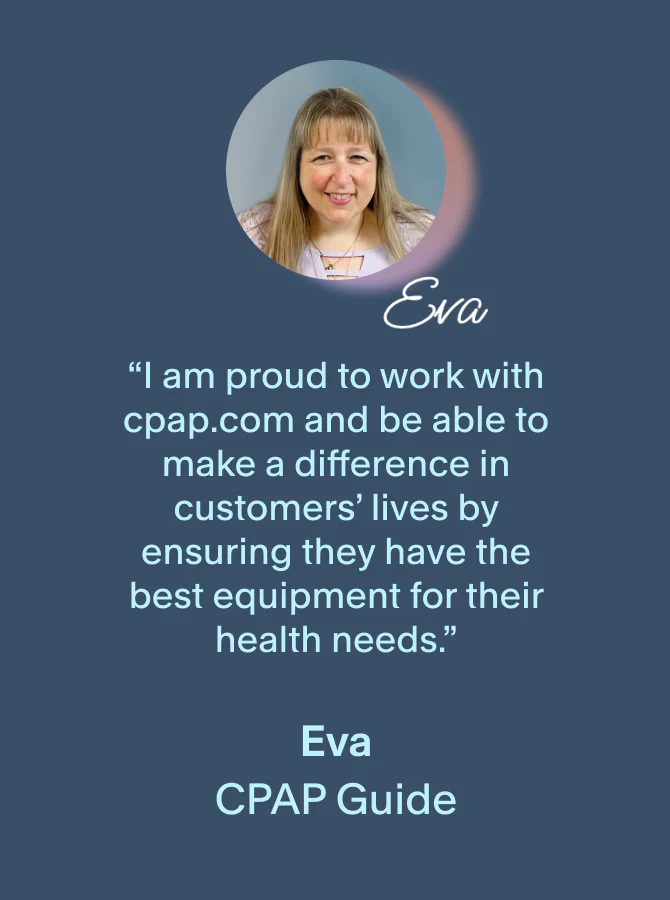Our content undergoes rigorous expert review, evidence-based research, and regular updates for accuracy.
Modern CPAP machines are incredibly sophisticated and capable devices that can provide a wide range of specific results recorded as data throughout the night. It's important to understand and monitor the CPAP machine readings so you and your doctor can be assured your CPAP therapy is working as it should.
Although these machines can vary by function, complexity, and price, the best are those that include a variety of statistics about your sleep patterns each night. Many come with a smiley face that lets you know everything is running properly and a frowning face to let you know there's a problem.
While these are fairly easy to interpret, you should really understand what the acronyms connected to the numbers are. Therefore, we'll go over some common readings that many CPAP machines measure, including
- AHI
- Pressure
- Leak
- Usage
AHI
AHI stands for Apnea Hypopnea Index. It illustrates the average number of hypopneas and apneas per hour for the timeframe. These terms represent the following:
- Hypopnea is a partial collapse of your airway.
- Apnea is the total absence of airflow through your mouth and nose, even when there's an effort to breathe (as in obstructive sleep apnea) as measured at the abdomen and chest.
The Apnea-Hypopnea Index (AHI) measurement is usually delivered within the setting of a sleep study report. It's the number of times per sleep hour that your upper airway (soft palate at your throat or tongue) partially or completely collapses, causing a drop in blood oxygen levels or a slight arousal from sleep.
The Apnea-Hypopnea Index is typically used for classifying how severe your sleep apnea is. It's also used to determine how well treatment is working — like a CPAP device, for instance.
The severity of Obstructive Sleep Apnea Hypopnea Syndrome (OSAHS), according to the American Academy of Sleep Medicine Task Force follows the below categories.
- Normal: Fewer than five breathing episodes per sleep hour.
- Mild Sleep Apnea: Five to 14.9 breathing episodes per sleep hour
- Moderate Sleep Apnea: Fifteen to 29.9 breathing episodes per sleep hour
- Severe Sleep Apnea: Thirty or more breathing episodes per sleep hour
To calculate AHI, you add the total number of apnea episodes, including hypopnea episodes, and divide by the number of sleep time minutes. You then take this number and multiply by 60.
Here's an example:
Divide hypopnea + apnea by sleep time and then multiply the number by 60.
- Apneas (200), Hypopnea (200) = Total number of episodes is 400
- Actual sleep time (420 minutes) (seven hours x 60 minutes)
- Divide the 400 by 420 = .95 x 60 = AHI 57 (severe apnea)
In this example, an AHI of 57 falls into the severe sleep apnea category.
Sleep is analyzed in children with more stringent criteria. More than one episode per sleep hour is considered abnormal.
Related Reading: How to Improve Your AHI Score Overnight
Pressure
This is the pressure the device is set at. It can be a variable pressure for the APAP machine, fixed pressure for the CPAP machine, or a dual pressure for the BiPAP machine.
Each individual is unique, therefore it seems sensible that CPAP therapy offers different pressure settings and not everyone would require the same setting for their obstructive sleep apnea (OSA). You can adjust the CPAP pressure to fit your own particular needs. And, while a low setting may be good for you, it might not be good for another person.
If your sleep study indicates you have OSA, you'll require a CPAP titration study to find the level of pressure you'll require to maintain your airway while you're sleeping. The sleep professional may perform the titration study the same night as your sleep study or you might schedule it for a later date.
Titration refers to slowly adding more of something until you achieve the desired effect. The sleep professional:
- Monitors your sleep during your titration study and slowly.
- Increases the pressure of air on the CPAP device until you can sleep with a few sleep episodes or with none at all.
Throughout the night, your pressure needs may vary, therefore you would need an overnight sleep study so the technician can determine and prescribe the proper pressure level.
The CPAP pressure level will be prescribed to the highest level you require during the night. The doctor prescribes the highest pressure in hopes of preventing as many sleep episodes as they can. But, with this approach, however, you'll receive the highest pressure all the time even when you only require it for part of the night.
APAP machines adjust the pressure on a breath by breath basis. This you might find helps your treatment.
Factors Affecting The Pressure Setting You Need
Your upper airway anatomy and the nature of your airway obstruction play the biggest role in figuring out the required pressure setting. Different amounts of air will be needed if your sleep apnea occurs due to:
- Deviated septum
- Blocked nose from allergies
- Tongue falls back into your airway
- A collapsing soft palate
Also, being obese or overweight could exacerbate things. In fact, when individuals lose around 10 percent body weight, they may need to turn down the CPAP settings.
Medications that relax the muscles of the airway (i.e. benzodiazepines), alcohol and sleeping your back could add to your pressure requirements temporarily.>
REM sleep towards morning could relax your muscles and exacerbate sleep apnea.
CPAP Leak
CPAP leak rate is usually measured in liters per minute, there's a built-in leak differential by masks since they all have variations because of the exhalation port. However, if there's an excessive leak, it could indicate a mouth leak or poor fitting mask.
There's a certain amount of leak coming from the mask that's considered normal. The manufacturer of the mask determines this amount and it's called the "intentional link" value. If your mask is leaking and its six to nine months old, consider replacing it. If it's new and is leaking, it could be due to an incorrect fit.
Masks could cause air leaks if they are:
- Too old: As the masks silicone cushion gets older, it deteriorates and starts becoming too soft to hold the seal. For a lot of masks, you can remove and replace it to extend the mask's life. When a cushion has become softened to where it doesn't hold a seal any longer, you might be able to tighten it up enough to stop the leak when you go to sleep, however, the seal will loosen and leak during the night.
- Too big: If air is leaking into your eyes or at the base of your nose, that typically means the mask is too wide or long. You may also experience a leak under your nose if you have facial hair.
- The wrong style: You could simply be using the wrong CPAP mask style for your unique facial structure, type of breathing, sleep style, and sleep apnea severity.
- Changing their position because your pillow pushing against the mask. You can purchase special CPAP pillows designed to reduce the contact of the mask with the pillow, even if you sleep on your side.
Today’s CPAP machines are designed to cope with some degree of an excessive leak by blowing more air into the semi-closed system to preserve the desired pressure setting.
When the excessive leaking reaches the level where the machine's manufacturers believe the machine will not properly maintain the therapeutic pressure setting, the leak is said to be a “Large Leak”.
Each manufacturer defines and flags unique defines what’s constitutes a large leak, and are reported as Total Leak Rathis rate includes both the excessive leak and the intentional leak made for preventing re-breathing the CO2.
Most machines categorize a normal leak rate if the leak registers 20-24L/minute or less, but you should always know what constitutes a higher than normal leak rate on your machine.
Usage
Your CPAP usage is determined by how long you wear the mask. Modern devices can differentiate the mask actually being on the person ―or if the person just turns it on but doesn't wear the mask. This measurement helps to assess compliance and is a factor that insurance companies measure for coverage purposes.
Compliance tracking machine can track usage hours, but may not track advanced features, such as AHI and leaks. Manufacturers designed compliance tracking machines to meet Medicare's requirements mandating durable medical equipment providers show the equipment was used for Medicare's set minimum number of hours. Without this data, DME providers can't continue being paid by Medicare.
A usage threshold determines the minimum time that you must use your device in order to be compliant.
Interpreting Your CPAP Readings In Conjunction with How You Feel
It’s important to understand and monitor your CPAP machine readings. But it’s also important to assess how you’re feeling after you've been using CPAP therapy for several months. For instance, do you still require naps or are you feeling less tired? Are you able to sleep through the night or if you're still waking up frequently? These questions can be a clue as to how well your CPAP therapy is working.
This self-assessment can help determine if the CPAP therapy is working optimally for you or not. If not, you may require adjustments to your CPAP therapy, whether it is a new CPAP machine, alternate CPAP mask, or other CPAP accessory.








